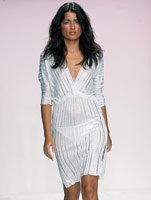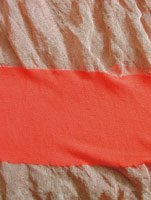Designers Go Green With Sustainable Fabrics
Kate O’Connor is known for creating ponchos and knits that languidly drape a woman’s curves. The Los Angeles–based designer—who typically uses alpaca, silk and other supple yarns for her designs—recently discovered something new: bamboo.
“I was looking for an alternative to the silk,” O’Connor explained. She couldn’t afford the best silk, which costs $65 a pound. Cotton, she found, can be “sticky” and lacks silk’s fluidity. A few months ago, her supplier at Silk City Fibers in New Jersey gave her some dyed bamboo yarn. O’Connor said bamboo is like a cotton-and-silk blend. “It feels light but has a silky weight to it, which is so gorgeous,” she gushed.
In late October at her Spring/Summer 2005 fashion show at Mercedes-Benz Fashion Week at Smashbox Studios in Culver City, O’Connor unveiled, among other pieces, striped halters and long skirts knitted with bamboo yarn. Compared with silk and cotton, bamboo is “so much cheaper, and it’s really good for the environment,” she said. Of the approximately 2,000 knits she expects to ship for the season, at least half will be made of bamboo. “This is the perfect summer fabric,” she noted.
O’Connor is joined by a growing band of local designers and manufacturers integrating “green” fabrics such as bamboo into upcoming collections. Seeking a substitute for cashmere, Amanda Shi turned to bamboo for her Avita line. Linda Loudermilk, a fan of organic cotton, introduced sasawashi, a blend of Japanese paper and kumazasa herb, which resembles linen. Ventura, Calif.–based Patagonia Inc., which has used organic cotton fabrics in its collection in the past, is also exploring bamboo-based fabrics, although the company hasn’t yet incorporated them into its outdoor clothes, a spokesperson said.
In addition to being less expensive and more environmentally friendly than luxury textiles such as silk and cashmere, the green fabrics also enable designers to attract vegetarian and vegan customers who shun animalbased products. The novelty is a plus.
Unlike cashmere, there are no quotas on imported bamboo fabric, although the duty paid on bamboo totals 33 percent, compared with roughly 7 percent for cashmere. Even so, the duty and quota on a cashmere sweater would total about $12 to $14, whereas the duty on a bamboo sweater would be approximately $5, according to Avita’s Shi.
Yet, no matter what the message and motives are, fashions made from green fabrics will likely be judged by consumers using the same criteria they use to evaluate other textiles, said Kevin Jones, curator at the Fashion Institute of Design & Merchandising Museum in Los Angeles.
“The public will accept any kind of material as long as it is comfortable and stylish,” he said, adding that paper dresses have been in existence for more than 300 years. He added that Japanese designers, including Issey Miyake and Commes des Garccedil;ons’ Rei Kawakubo, have been using bamboo, paper and even pineapple fibers in their avant-garde designs since the late 1970s.
One reason Los Angeles designers are adopting the green fabrics now is because such materials are becoming increasingly available. Peter Sagal, O’Connor’s supplier and president of Silk City Fibers in Paterson, N.J., said he came across bamboo yarn two years ago. He waited until this past spring to offer the yarn because he first searched for vendors who could dye the bamboo fiber evenly and spin it into three different weights. Available in a minimum of 28 colors for an average price of $14.50 a pound, bamboo has been an easy sell, he said. He added that his company is developing cotton that is grown organically in Egypt and dyed ecologically in Germany.
Rich Delano, president of Bamboo Textile in Brea, Calif., imports Chinese bamboo yarn for six customers, including underwear maker Stone International LLC of Columbia, S.C. He said his clients are in the development stage. He pointed out that, besides being soft, bamboo yarn is antibacterial and nearly three times more absorbent than cotton.
Cashmere from plants
One year ago, Avita’s Shi asked her family’s factory in China to find a fabric that is lighter than a silk-and-cashmere blend and can be worn in the summer. Six months later, Wing Sun Textiles, which makes private-label knits, sent her a black tank made out of bamboo. Shi said bamboo was more matte than Tencel and viscose and thicker than Modal fiber. She also said bamboo yarn is stronger than cashmere and stretches more than a silk-and-cashmere blend. What’s more, bamboo doesn’t pill as easily as synthetic yarns, she said. Shi will debut the bamboo knits for Spring 2005. “People are calling it cashmere from plants,” she said.
The manufacturing process for bamboo yarn is similar to that for rayon. The bamboo stems and leaves are pummeled into a starchy pulp in hydrolysis alkalization. A finishing treatment transforms the pulp into soft fibers. The bamboo yarn is then bleached and dyed.
Shi said that a quarter of the 200 stores that sell her clothes, including Fred Segal in Santa Monica, Calif., have placed orders for bamboo knits such as asymmetrical skirts layered with Italian metal ($89 wholesale). She also gave samples to Wing Sun’s private-label clients, who, she said, liked them. Shi said her biggest challenge was deciding what to put on the care label; she concluded that it was best to dry-clean or hand wash the garments and then lay them flat to dry.
Loudermilk has undertaken the task of elevating eco-friendly fabrics from the realm of yoga and sportswear. “Environmental products can be of beautiful design,” she said, predicting that the green pieces will hold their own against clothes made by high-end labels such as Gucci.
Loudermilk will make 30 percent of her Spring 2005 collection from sasawashi, provided by Japan’s Katsu Kawasaki; 25 percent from bamboo; and l0 percent from Tencel. The remainder will consist of organic cotton and recycled fabrics. Loudermilk’s sasawashi skirt with frazzled seams and an asymmetrical hem will wholesale for $555.
Loudermilk, whose clothes are carried by retailers such as Saks Fifth Avenue in Saudi Arabia, said a dozen stores have ordered the sasawashi garments. She plans to open a shop of her own in March on Croft Avenue in Los Angeles and stock not only her clothes but also what she considers the best of ecologically minded books, children’s toys and other items.
True black and other shades
Greg Niebel is one retailer attracted to bamboo. Niebel— who carries O’Connor, Miyake and other forward fashion at BNY in Santa Monica—said black is a dominant color in his shop. “Sometimes, with the natural fibers, you can’t get a true, true black,” he said.
O’Connor, he noted, successfully found a rich black in the bamboo yarn. He said 65 percent of his O’Connor order will be for the bamboo knits, including a drop-stitch dress ($220 wholesale).
The tints were important to O’Connor, an art-school graduate who dubs herself “a color freak.” While cotton offers the widest palette, bamboo comes in lavender, mint and additional hues that she cannot obtain in other yarns, she said.
























